Na+ Regulation in the Malaria Parasite Plasmodium Falciparum
VerifiedAdded on 2023/01/23
|10
|2561
|32
AI Summary
This study explores the regulation of sodium ion (Na+) in the malaria parasite Plasmodium falciparum. It discusses the mechanisms and pathways involved in Na+ regulation and the role of PfATP4. The study also investigates the effects of spirondolones, a class of anti-malaria drugs, on Na+ regulation. The findings provide insights into the regulation of Na+ in the malaria parasite and its implications.
Contribute Materials
Your contribution can guide someone’s learning journey. Share your
documents today.
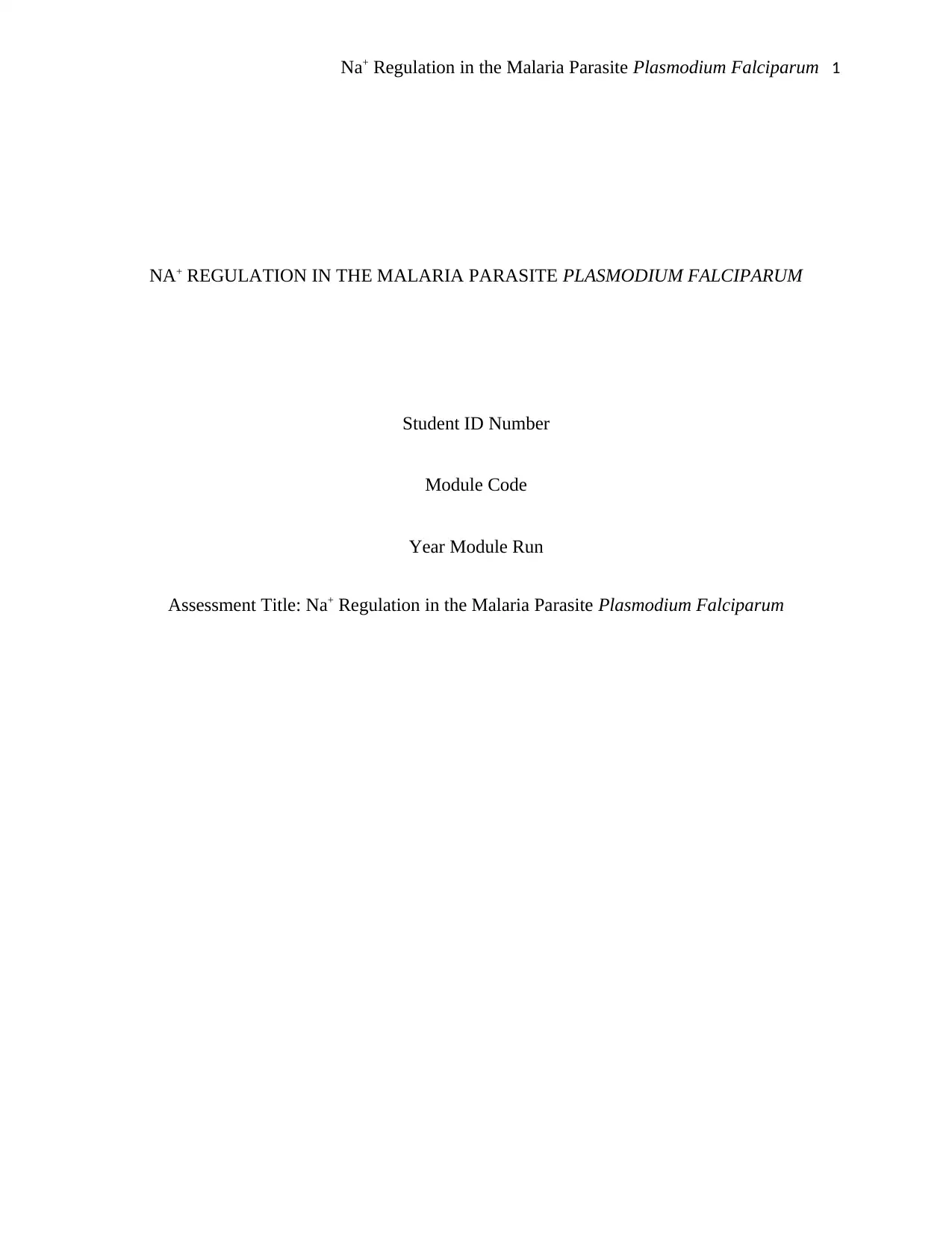
Na+ Regulation in the Malaria Parasite Plasmodium Falciparum 1
NA+ REGULATION IN THE MALARIA PARASITE PLASMODIUM FALCIPARUM
Student ID Number
Module Code
Year Module Run
Assessment Title: Na+ Regulation in the Malaria Parasite Plasmodium Falciparum
NA+ REGULATION IN THE MALARIA PARASITE PLASMODIUM FALCIPARUM
Student ID Number
Module Code
Year Module Run
Assessment Title: Na+ Regulation in the Malaria Parasite Plasmodium Falciparum
Secure Best Marks with AI Grader
Need help grading? Try our AI Grader for instant feedback on your assignments.

Na+ Regulation in the Malaria Parasite Plasmodium Falciparum 2
Na+ Regulation in the Malaria Parasite Plasmodium Falciparum
Introduction
Plasmodium falciparum is the human parasite that causes malaria in the human body
through a mosquito bite. The parasite then enters the body of the infected human body with high
level of sodium ion (Na+) and penetrates into the low potassium state K+ blood plasma and enters
into higher K+ in the cyst sol cell. In a period of twelve to sixteen hours after invasion of the
parasite, it then slowly establishes itself in the plasma membrane (Greenbaum et al.,
2002).Therefore; it creates pathways for the uptake of various nutrients to the infected human
cell. Study shows that malaria parasite develops into the erythrocyte membrane which provides it
with some nutrients into the infected cell. Evidently, intra erythrocytes parasite normally
separates cytosolic in the opposite direction of the gradient through calcium ATPase (PfATP4).
Intra erythrocyte parasite consistently maintains its low level of cytosolic (Na+) content
irrespective of the higher level of sodium ion (Na+) from its external pathways (Spillman et
al.,2013).
Consequently, the pathways allow the uptake of {Na+} into the infected cell thus increasing
the levels of sodium ion {Na+}. This mechanism is normally applied in the plants fungi of the
lower plants and sodium ion {Na+} of the protozoan extracted from exitus natus known as ENA
that is P type of the ATPase of sodium {Na+} ion (Dennis et al.,2018). Arguably, ENA has a
relationship with endoplasmic reticulum of calcium ion Ca2+ ATPase resulting into sodium {Na+}
ion of the misannoted family. In the process spirondolones perform the role of ant malaria
showing a resistant activity against falciparum at the blood stage P. It is argued that in the past
twenty years the spirondolones has entered second phase of the clinical tests in the discovery of
Na+ Regulation in the Malaria Parasite Plasmodium Falciparum
Introduction
Plasmodium falciparum is the human parasite that causes malaria in the human body
through a mosquito bite. The parasite then enters the body of the infected human body with high
level of sodium ion (Na+) and penetrates into the low potassium state K+ blood plasma and enters
into higher K+ in the cyst sol cell. In a period of twelve to sixteen hours after invasion of the
parasite, it then slowly establishes itself in the plasma membrane (Greenbaum et al.,
2002).Therefore; it creates pathways for the uptake of various nutrients to the infected human
cell. Study shows that malaria parasite develops into the erythrocyte membrane which provides it
with some nutrients into the infected cell. Evidently, intra erythrocytes parasite normally
separates cytosolic in the opposite direction of the gradient through calcium ATPase (PfATP4).
Intra erythrocyte parasite consistently maintains its low level of cytosolic (Na+) content
irrespective of the higher level of sodium ion (Na+) from its external pathways (Spillman et
al.,2013).
Consequently, the pathways allow the uptake of {Na+} into the infected cell thus increasing
the levels of sodium ion {Na+}. This mechanism is normally applied in the plants fungi of the
lower plants and sodium ion {Na+} of the protozoan extracted from exitus natus known as ENA
that is P type of the ATPase of sodium {Na+} ion (Dennis et al.,2018). Arguably, ENA has a
relationship with endoplasmic reticulum of calcium ion Ca2+ ATPase resulting into sodium {Na+}
ion of the misannoted family. In the process spirondolones perform the role of ant malaria
showing a resistant activity against falciparum at the blood stage P. It is argued that in the past
twenty years the spirondolones has entered second phase of the clinical tests in the discovery of
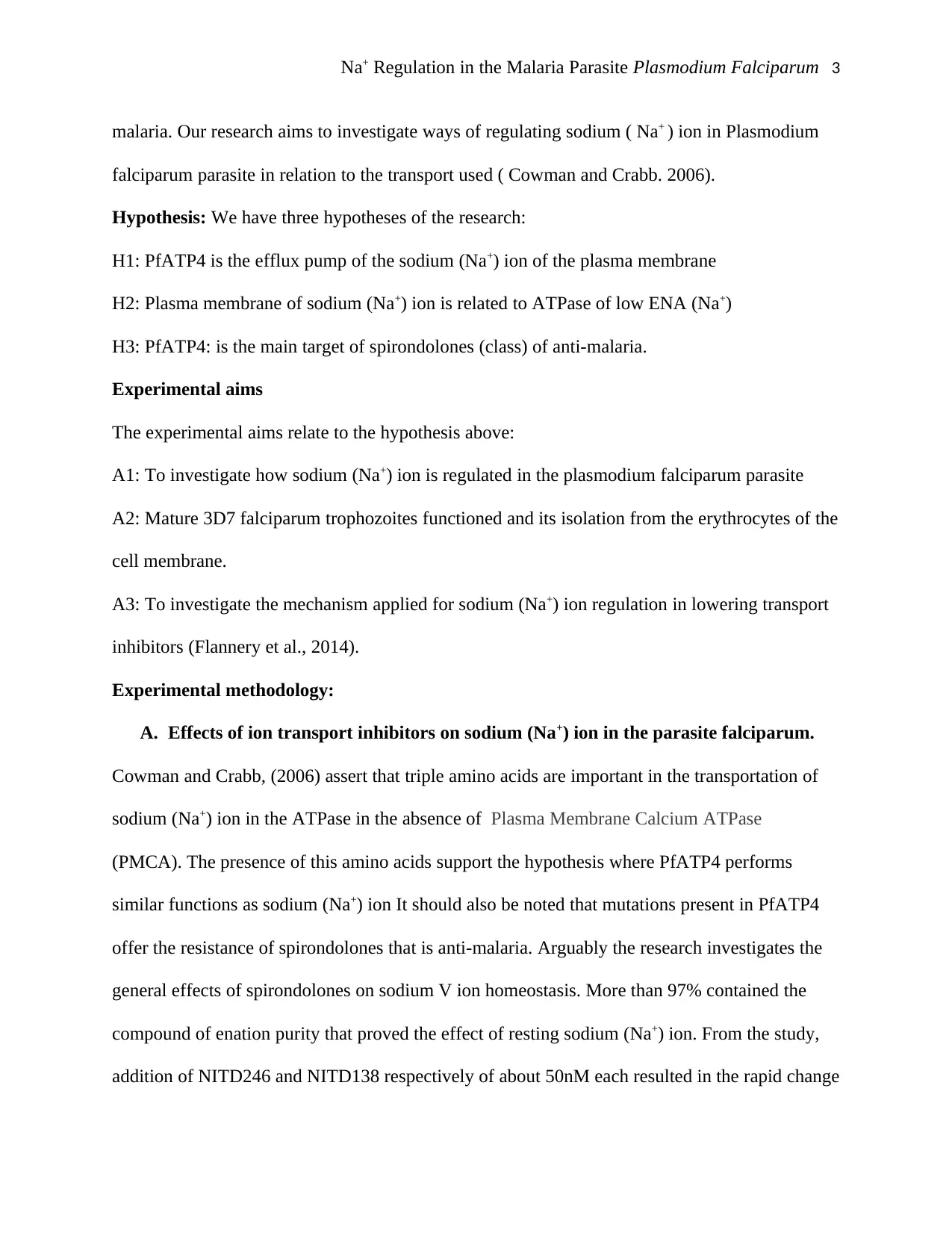
Na+ Regulation in the Malaria Parasite Plasmodium Falciparum 3
malaria. Our research aims to investigate ways of regulating sodium ( Na+ ) ion in Plasmodium
falciparum parasite in relation to the transport used ( Cowman and Crabb. 2006).
Hypothesis: We have three hypotheses of the research:
H1: PfATP4 is the efflux pump of the sodium (Na+) ion of the plasma membrane
H2: Plasma membrane of sodium (Na+) ion is related to ATPase of low ENA (Na+)
H3: PfATP4: is the main target of spirondolones (class) of anti-malaria.
Experimental aims
The experimental aims relate to the hypothesis above:
A1: To investigate how sodium (Na+) ion is regulated in the plasmodium falciparum parasite
A2: Mature 3D7 falciparum trophozoites functioned and its isolation from the erythrocytes of the
cell membrane.
A3: To investigate the mechanism applied for sodium (Na+) ion regulation in lowering transport
inhibitors (Flannery et al., 2014).
Experimental methodology:
A. Effects of ion transport inhibitors on sodium (Na+) ion in the parasite falciparum.
Cowman and Crabb, (2006) assert that triple amino acids are important in the transportation of
sodium (Na+) ion in the ATPase in the absence of Plasma Membrane Calcium ATPase
(PMCA). The presence of this amino acids support the hypothesis where PfATP4 performs
similar functions as sodium (Na+) ion It should also be noted that mutations present in PfATP4
offer the resistance of spirondolones that is anti-malaria. Arguably the research investigates the
general effects of spirondolones on sodium V ion homeostasis. More than 97% contained the
compound of enation purity that proved the effect of resting sodium (Na+) ion. From the study,
addition of NITD246 and NITD138 respectively of about 50nM each resulted in the rapid change
malaria. Our research aims to investigate ways of regulating sodium ( Na+ ) ion in Plasmodium
falciparum parasite in relation to the transport used ( Cowman and Crabb. 2006).
Hypothesis: We have three hypotheses of the research:
H1: PfATP4 is the efflux pump of the sodium (Na+) ion of the plasma membrane
H2: Plasma membrane of sodium (Na+) ion is related to ATPase of low ENA (Na+)
H3: PfATP4: is the main target of spirondolones (class) of anti-malaria.
Experimental aims
The experimental aims relate to the hypothesis above:
A1: To investigate how sodium (Na+) ion is regulated in the plasmodium falciparum parasite
A2: Mature 3D7 falciparum trophozoites functioned and its isolation from the erythrocytes of the
cell membrane.
A3: To investigate the mechanism applied for sodium (Na+) ion regulation in lowering transport
inhibitors (Flannery et al., 2014).
Experimental methodology:
A. Effects of ion transport inhibitors on sodium (Na+) ion in the parasite falciparum.
Cowman and Crabb, (2006) assert that triple amino acids are important in the transportation of
sodium (Na+) ion in the ATPase in the absence of Plasma Membrane Calcium ATPase
(PMCA). The presence of this amino acids support the hypothesis where PfATP4 performs
similar functions as sodium (Na+) ion It should also be noted that mutations present in PfATP4
offer the resistance of spirondolones that is anti-malaria. Arguably the research investigates the
general effects of spirondolones on sodium V ion homeostasis. More than 97% contained the
compound of enation purity that proved the effect of resting sodium (Na+) ion. From the study,
addition of NITD246 and NITD138 respectively of about 50nM each resulted in the rapid change
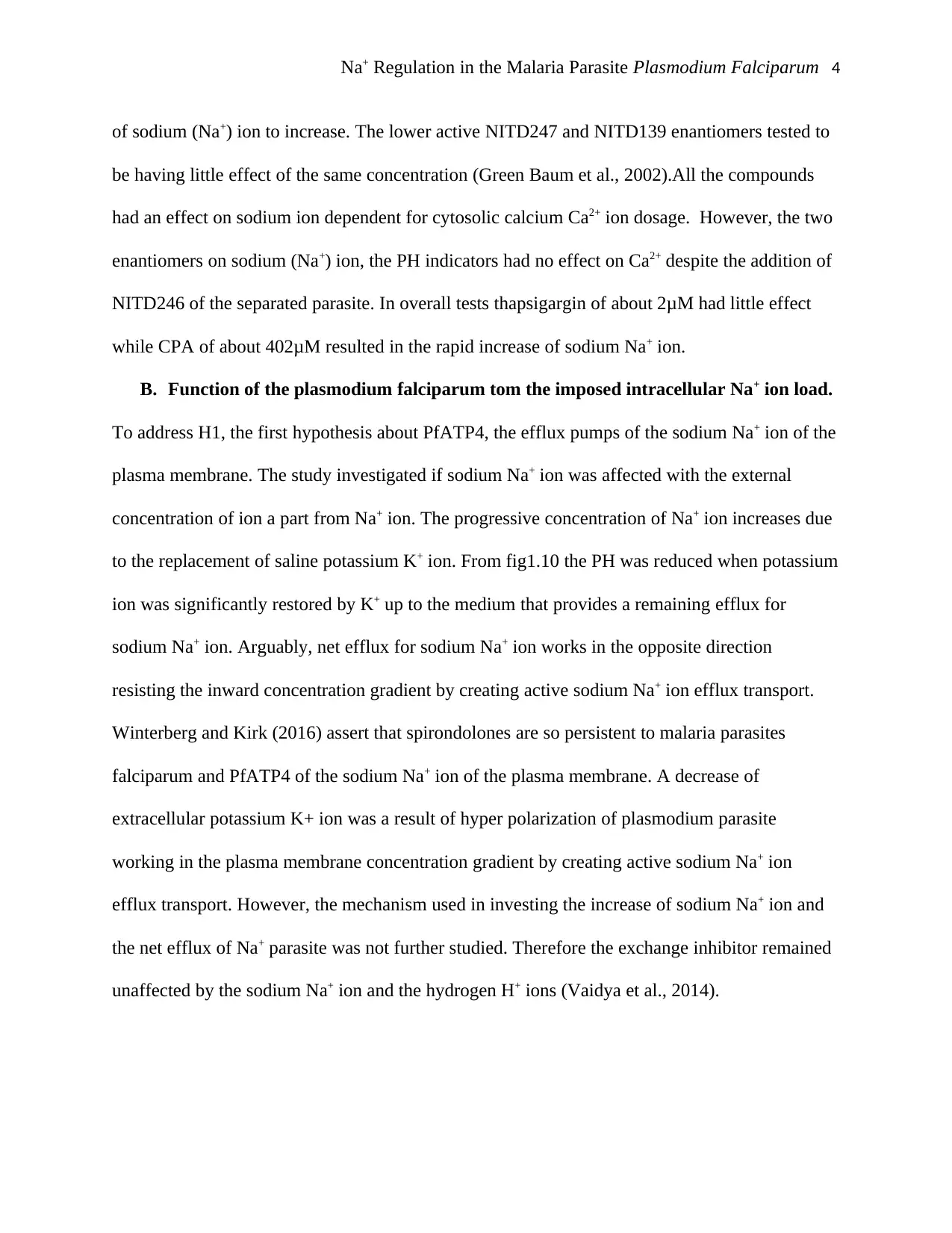
Na+ Regulation in the Malaria Parasite Plasmodium Falciparum 4
of sodium (Na+) ion to increase. The lower active NITD247 and NITD139 enantiomers tested to
be having little effect of the same concentration (Green Baum et al., 2002).All the compounds
had an effect on sodium ion dependent for cytosolic calcium Ca2+ ion dosage. However, the two
enantiomers on sodium (Na+) ion, the PH indicators had no effect on Ca2+ despite the addition of
NITD246 of the separated parasite. In overall tests thapsigargin of about 2μM had little effect
while CPA of about 402μM resulted in the rapid increase of sodium Na+ ion.
B. Function of the plasmodium falciparum tom the imposed intracellular Na+ ion load.
To address H1, the first hypothesis about PfATP4, the efflux pumps of the sodium Na+ ion of the
plasma membrane. The study investigated if sodium Na+ ion was affected with the external
concentration of ion a part from Na+ ion. The progressive concentration of Na+ ion increases due
to the replacement of saline potassium K+ ion. From fig1.10 the PH was reduced when potassium
ion was significantly restored by K+ up to the medium that provides a remaining efflux for
sodium Na+ ion. Arguably, net efflux for sodium Na+ ion works in the opposite direction
resisting the inward concentration gradient by creating active sodium Na+ ion efflux transport.
Winterberg and Kirk (2016) assert that spirondolones are so persistent to malaria parasites
falciparum and PfATP4 of the sodium Na+ ion of the plasma membrane. A decrease of
extracellular potassium K+ ion was a result of hyper polarization of plasmodium parasite
working in the plasma membrane concentration gradient by creating active sodium Na+ ion
efflux transport. However, the mechanism used in investing the increase of sodium Na+ ion and
the net efflux of Na+ parasite was not further studied. Therefore the exchange inhibitor remained
unaffected by the sodium Na+ ion and the hydrogen H+ ions (Vaidya et al., 2014).
of sodium (Na+) ion to increase. The lower active NITD247 and NITD139 enantiomers tested to
be having little effect of the same concentration (Green Baum et al., 2002).All the compounds
had an effect on sodium ion dependent for cytosolic calcium Ca2+ ion dosage. However, the two
enantiomers on sodium (Na+) ion, the PH indicators had no effect on Ca2+ despite the addition of
NITD246 of the separated parasite. In overall tests thapsigargin of about 2μM had little effect
while CPA of about 402μM resulted in the rapid increase of sodium Na+ ion.
B. Function of the plasmodium falciparum tom the imposed intracellular Na+ ion load.
To address H1, the first hypothesis about PfATP4, the efflux pumps of the sodium Na+ ion of the
plasma membrane. The study investigated if sodium Na+ ion was affected with the external
concentration of ion a part from Na+ ion. The progressive concentration of Na+ ion increases due
to the replacement of saline potassium K+ ion. From fig1.10 the PH was reduced when potassium
ion was significantly restored by K+ up to the medium that provides a remaining efflux for
sodium Na+ ion. Arguably, net efflux for sodium Na+ ion works in the opposite direction
resisting the inward concentration gradient by creating active sodium Na+ ion efflux transport.
Winterberg and Kirk (2016) assert that spirondolones are so persistent to malaria parasites
falciparum and PfATP4 of the sodium Na+ ion of the plasma membrane. A decrease of
extracellular potassium K+ ion was a result of hyper polarization of plasmodium parasite
working in the plasma membrane concentration gradient by creating active sodium Na+ ion
efflux transport. However, the mechanism used in investing the increase of sodium Na+ ion and
the net efflux of Na+ parasite was not further studied. Therefore the exchange inhibitor remained
unaffected by the sodium Na+ ion and the hydrogen H+ ions (Vaidya et al., 2014).
Secure Best Marks with AI Grader
Need help grading? Try our AI Grader for instant feedback on your assignments.
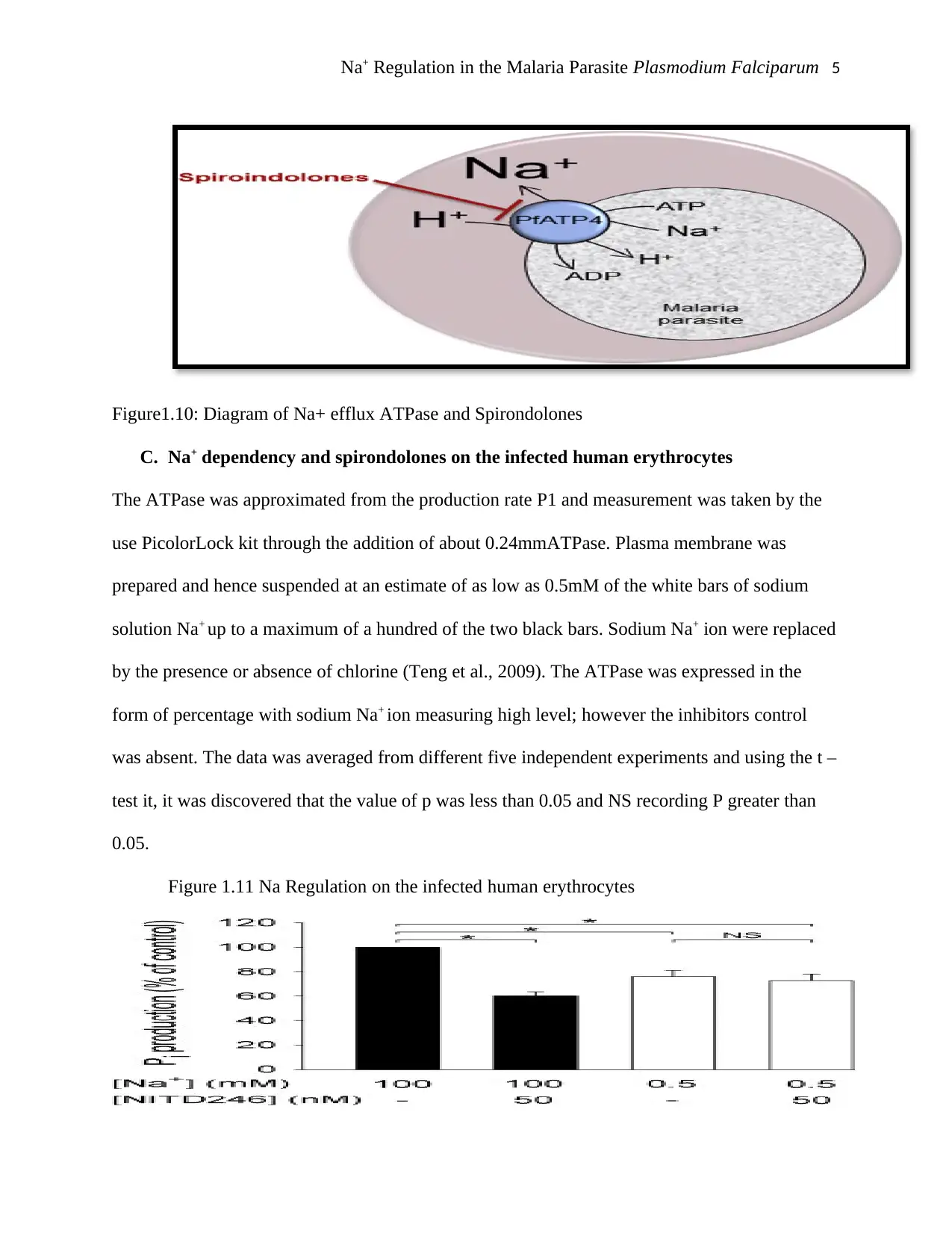
Na+ Regulation in the Malaria Parasite Plasmodium Falciparum 5
Figure1.10: Diagram of Na+ efflux ATPase and Spirondolones
C. Na+ dependency and spirondolones on the infected human erythrocytes
The ATPase was approximated from the production rate P1 and measurement was taken by the
use PicolorLock kit through the addition of about 0.24mmATPase. Plasma membrane was
prepared and hence suspended at an estimate of as low as 0.5mM of the white bars of sodium
solution Na+ up to a maximum of a hundred of the two black bars. Sodium Na+ ion were replaced
by the presence or absence of chlorine (Teng et al., 2009). The ATPase was expressed in the
form of percentage with sodium Na+ ion measuring high level; however the inhibitors control
was absent. The data was averaged from different five independent experiments and using the t –
test it, it was discovered that the value of p was less than 0.05 and NS recording P greater than
0.05.
Figure 1.11 Na Regulation on the infected human erythrocytes
Figure1.10: Diagram of Na+ efflux ATPase and Spirondolones
C. Na+ dependency and spirondolones on the infected human erythrocytes
The ATPase was approximated from the production rate P1 and measurement was taken by the
use PicolorLock kit through the addition of about 0.24mmATPase. Plasma membrane was
prepared and hence suspended at an estimate of as low as 0.5mM of the white bars of sodium
solution Na+ up to a maximum of a hundred of the two black bars. Sodium Na+ ion were replaced
by the presence or absence of chlorine (Teng et al., 2009). The ATPase was expressed in the
form of percentage with sodium Na+ ion measuring high level; however the inhibitors control
was absent. The data was averaged from different five independent experiments and using the t –
test it, it was discovered that the value of p was less than 0.05 and NS recording P greater than
0.05.
Figure 1.11 Na Regulation on the infected human erythrocytes
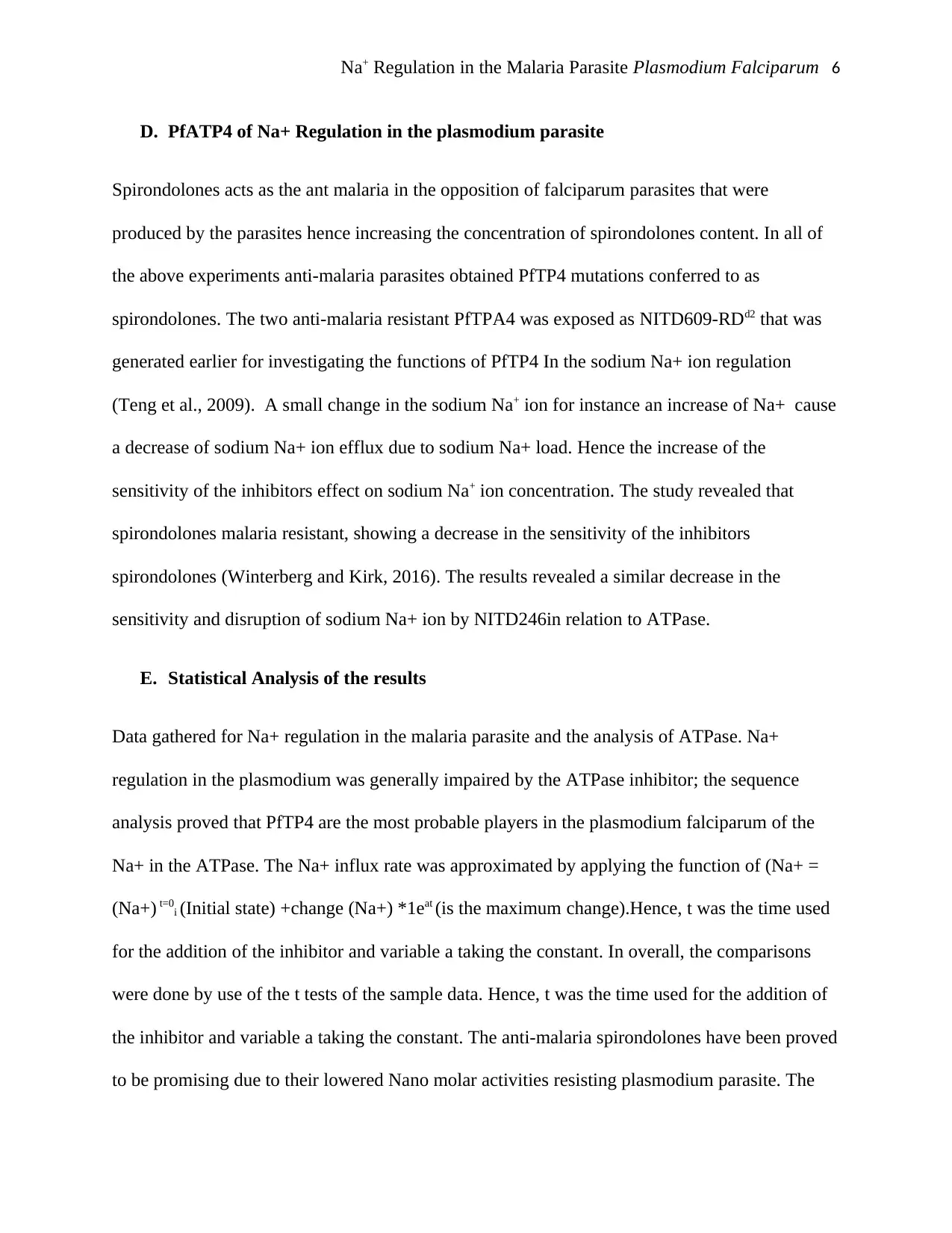
Na+ Regulation in the Malaria Parasite Plasmodium Falciparum 6
D. PfATP4 of Na+ Regulation in the plasmodium parasite
Spirondolones acts as the ant malaria in the opposition of falciparum parasites that were
produced by the parasites hence increasing the concentration of spirondolones content. In all of
the above experiments anti-malaria parasites obtained PfTP4 mutations conferred to as
spirondolones. The two anti-malaria resistant PfTPA4 was exposed as NITD609-RDd2 that was
generated earlier for investigating the functions of PfTP4 In the sodium Na+ ion regulation
(Teng et al., 2009). A small change in the sodium Na+ ion for instance an increase of Na+ cause
a decrease of sodium Na+ ion efflux due to sodium Na+ load. Hence the increase of the
sensitivity of the inhibitors effect on sodium Na+ ion concentration. The study revealed that
spirondolones malaria resistant, showing a decrease in the sensitivity of the inhibitors
spirondolones (Winterberg and Kirk, 2016). The results revealed a similar decrease in the
sensitivity and disruption of sodium Na+ ion by NITD246in relation to ATPase.
E. Statistical Analysis of the results
Data gathered for Na+ regulation in the malaria parasite and the analysis of ATPase. Na+
regulation in the plasmodium was generally impaired by the ATPase inhibitor; the sequence
analysis proved that PfTP4 are the most probable players in the plasmodium falciparum of the
Na+ in the ATPase. The Na+ influx rate was approximated by applying the function of (Na+ =
(Na+) t=0i (Initial state) +change (Na+) *1eat (is the maximum change).Hence, t was the time used
for the addition of the inhibitor and variable a taking the constant. In overall, the comparisons
were done by use of the t tests of the sample data. Hence, t was the time used for the addition of
the inhibitor and variable a taking the constant. The anti-malaria spirondolones have been proved
to be promising due to their lowered Nano molar activities resisting plasmodium parasite. The
D. PfATP4 of Na+ Regulation in the plasmodium parasite
Spirondolones acts as the ant malaria in the opposition of falciparum parasites that were
produced by the parasites hence increasing the concentration of spirondolones content. In all of
the above experiments anti-malaria parasites obtained PfTP4 mutations conferred to as
spirondolones. The two anti-malaria resistant PfTPA4 was exposed as NITD609-RDd2 that was
generated earlier for investigating the functions of PfTP4 In the sodium Na+ ion regulation
(Teng et al., 2009). A small change in the sodium Na+ ion for instance an increase of Na+ cause
a decrease of sodium Na+ ion efflux due to sodium Na+ load. Hence the increase of the
sensitivity of the inhibitors effect on sodium Na+ ion concentration. The study revealed that
spirondolones malaria resistant, showing a decrease in the sensitivity of the inhibitors
spirondolones (Winterberg and Kirk, 2016). The results revealed a similar decrease in the
sensitivity and disruption of sodium Na+ ion by NITD246in relation to ATPase.
E. Statistical Analysis of the results
Data gathered for Na+ regulation in the malaria parasite and the analysis of ATPase. Na+
regulation in the plasmodium was generally impaired by the ATPase inhibitor; the sequence
analysis proved that PfTP4 are the most probable players in the plasmodium falciparum of the
Na+ in the ATPase. The Na+ influx rate was approximated by applying the function of (Na+ =
(Na+) t=0i (Initial state) +change (Na+) *1eat (is the maximum change).Hence, t was the time used
for the addition of the inhibitor and variable a taking the constant. In overall, the comparisons
were done by use of the t tests of the sample data. Hence, t was the time used for the addition of
the inhibitor and variable a taking the constant. The anti-malaria spirondolones have been proved
to be promising due to their lowered Nano molar activities resisting plasmodium parasite. The

Na+ Regulation in the Malaria Parasite Plasmodium Falciparum 7
comparisons also were used in the justification of the hypothesis and targeting the anti-malaria
spirondolones (Green Baum et al., 2002).
Fig 1.12 Sodium Na+ Regulation and the sensitivity of the spirondolones
Strain Na+ (mm) Na+ Loading IC50
InhibitionNTD24
6 of parasite
IC50 ATPase
Activities
NITD609 of
RDd2 clone
8.2 156 0.09 1.8
Dd2parent 15.8 350 0.90 14.5
Dd2 of the
Parent
8.5 150 0.07 4.2
Table1.0
The table above shows the inhibition value for sodium Na+ ion parasite that was approximated as
(3H) for the use of hypoxanthine. Therefore, fifty percent of the inhibition proliferation was
required in the resting of sodium Na+ ion load in the saponin trophozoites. Sodium Na+ ion
resting value was calculated through fitting the experimental function of the time decay for the
rendition of potassium Chloride KCl cells. Sodium Na+ ion were as a result of doubled normal
value through free potassium K+ ion medium (Cowman and Crabb, 2006). The value of IC50 was
due to disruption of sodium Na+ ion regulation obtained from each of the inhibitors. The
disruption required for this change caused P1 rate to reduce by half of the maximum amount of
sodium Na+ ion. All of the above columns apart from the one pertaining sodium Na+ ion
regulation ATPase and the assumed mean of the rest variables were estimated as SEM. The IC50
comparisons also were used in the justification of the hypothesis and targeting the anti-malaria
spirondolones (Green Baum et al., 2002).
Fig 1.12 Sodium Na+ Regulation and the sensitivity of the spirondolones
Strain Na+ (mm) Na+ Loading IC50
InhibitionNTD24
6 of parasite
IC50 ATPase
Activities
NITD609 of
RDd2 clone
8.2 156 0.09 1.8
Dd2parent 15.8 350 0.90 14.5
Dd2 of the
Parent
8.5 150 0.07 4.2
Table1.0
The table above shows the inhibition value for sodium Na+ ion parasite that was approximated as
(3H) for the use of hypoxanthine. Therefore, fifty percent of the inhibition proliferation was
required in the resting of sodium Na+ ion load in the saponin trophozoites. Sodium Na+ ion
resting value was calculated through fitting the experimental function of the time decay for the
rendition of potassium Chloride KCl cells. Sodium Na+ ion were as a result of doubled normal
value through free potassium K+ ion medium (Cowman and Crabb, 2006). The value of IC50 was
due to disruption of sodium Na+ ion regulation obtained from each of the inhibitors. The
disruption required for this change caused P1 rate to reduce by half of the maximum amount of
sodium Na+ ion. All of the above columns apart from the one pertaining sodium Na+ ion
regulation ATPase and the assumed mean of the rest variables were estimated as SEM. The IC50
Paraphrase This Document
Need a fresh take? Get an instant paraphrase of this document with our AI Paraphraser
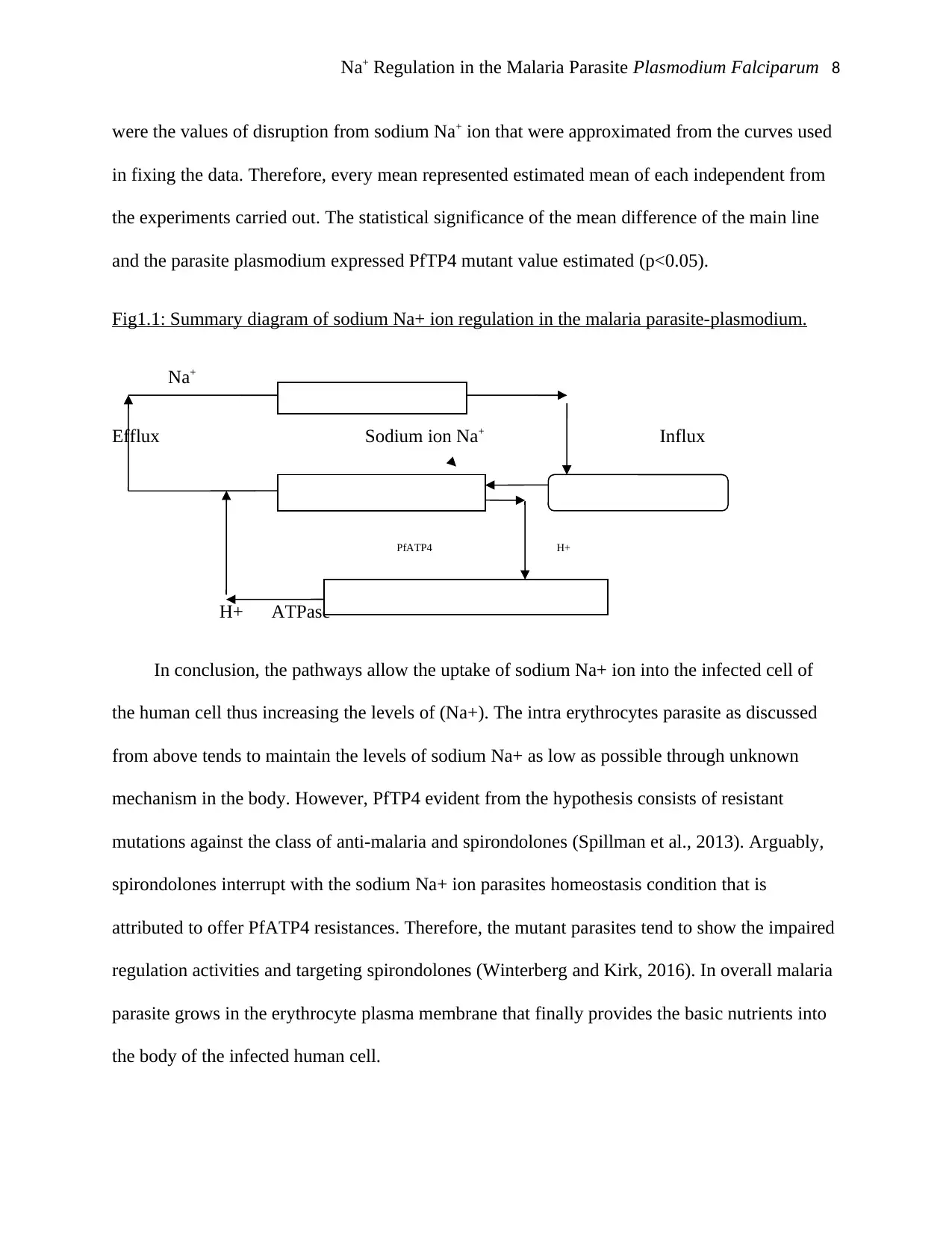
Na+ Regulation in the Malaria Parasite Plasmodium Falciparum 8
were the values of disruption from sodium Na+ ion that were approximated from the curves used
in fixing the data. Therefore, every mean represented estimated mean of each independent from
the experiments carried out. The statistical significance of the mean difference of the main line
and the parasite plasmodium expressed PfTP4 mutant value estimated (p<0.05).
Fig1.1: Summary diagram of sodium Na+ ion regulation in the malaria parasite-plasmodium.
Na+
Efflux Sodium ion Na+ Influx
PfATP4 H+
H+ ATPase
In conclusion, the pathways allow the uptake of sodium Na+ ion into the infected cell of
the human cell thus increasing the levels of (Na+). The intra erythrocytes parasite as discussed
from above tends to maintain the levels of sodium Na+ as low as possible through unknown
mechanism in the body. However, PfTP4 evident from the hypothesis consists of resistant
mutations against the class of anti-malaria and spirondolones (Spillman et al., 2013). Arguably,
spirondolones interrupt with the sodium Na+ ion parasites homeostasis condition that is
attributed to offer PfATP4 resistances. Therefore, the mutant parasites tend to show the impaired
regulation activities and targeting spirondolones (Winterberg and Kirk, 2016). In overall malaria
parasite grows in the erythrocyte plasma membrane that finally provides the basic nutrients into
the body of the infected human cell.
were the values of disruption from sodium Na+ ion that were approximated from the curves used
in fixing the data. Therefore, every mean represented estimated mean of each independent from
the experiments carried out. The statistical significance of the mean difference of the main line
and the parasite plasmodium expressed PfTP4 mutant value estimated (p<0.05).
Fig1.1: Summary diagram of sodium Na+ ion regulation in the malaria parasite-plasmodium.
Na+
Efflux Sodium ion Na+ Influx
PfATP4 H+
H+ ATPase
In conclusion, the pathways allow the uptake of sodium Na+ ion into the infected cell of
the human cell thus increasing the levels of (Na+). The intra erythrocytes parasite as discussed
from above tends to maintain the levels of sodium Na+ as low as possible through unknown
mechanism in the body. However, PfTP4 evident from the hypothesis consists of resistant
mutations against the class of anti-malaria and spirondolones (Spillman et al., 2013). Arguably,
spirondolones interrupt with the sodium Na+ ion parasites homeostasis condition that is
attributed to offer PfATP4 resistances. Therefore, the mutant parasites tend to show the impaired
regulation activities and targeting spirondolones (Winterberg and Kirk, 2016). In overall malaria
parasite grows in the erythrocyte plasma membrane that finally provides the basic nutrients into
the body of the infected human cell.

Na+ Regulation in the Malaria Parasite Plasmodium Falciparum 9
References
Cowman, A.F. and Crabb, B.S., 2006. Invasion of red blood cells by malaria
parasites. Cell, 124(4), pp.755-766.
Dennis, A.S., Lehane, A.M., Ridgway, M.C., Holleran, J.P. and Kirk, K., 2018. Cell swelling
induced by the antimalarial KAE609 (cipargamin) and other PfATP4-associated
antimalarials. Antimicrobial agents and chemotherapy, 62(6), pp.e00087-18.
Flannery, E.L., McNamara, C.W., Kim, S.W., Kato, T.S., Li, F., Teng, C.H., Gagaring, K.,
Manary, M.J., Barboa, R., Meister, S. and Kuhen, K., 2014. Mutations in the P-type cation-
transporter ATPase 4, PfATP4, mediate resistance to both aminopyrazole and spiroindolone
antimalarials. ACS chemical biology, 10(2), pp.413-420.
Greenbaum, D.C., Baruch, A., Grainger, M., Bozdech, Z., Medzihradszky, K.F., Engel, J.,
DeRisi, J., Holder, A.A. and Bogyo, M., 2002. A role for the protease falcipain 1 in host cell
invasion by the human malaria parasite. Science, 298(5600).
Spillman, N.J., Allen, R.J., McNamara, C.W., Yeung, B.K., Winzeler, E.A., Diagana, T.T. and
Kirk, K., 2013. Na+ regulation in the malaria parasite Plasmodium falciparum involves the
cation ATPase PfATP4 and is a target of the spiroindolone antimalarials. Cell host &
microbe, 13(2), pp.227-237.
Teng R, Junankar PR, Bubb WA, Rae C, Mercier P, Kirk K. Metabolite profiling of the
intraerythrocytic malaria parasite Plasmodium falciparum by 1H NMR spectroscopy. NMR in
Biomedicine: An International Journal Devoted to the Development and Application of Magnetic
Resonance In vivo. 2009 Apr;22(3):292-302.
References
Cowman, A.F. and Crabb, B.S., 2006. Invasion of red blood cells by malaria
parasites. Cell, 124(4), pp.755-766.
Dennis, A.S., Lehane, A.M., Ridgway, M.C., Holleran, J.P. and Kirk, K., 2018. Cell swelling
induced by the antimalarial KAE609 (cipargamin) and other PfATP4-associated
antimalarials. Antimicrobial agents and chemotherapy, 62(6), pp.e00087-18.
Flannery, E.L., McNamara, C.W., Kim, S.W., Kato, T.S., Li, F., Teng, C.H., Gagaring, K.,
Manary, M.J., Barboa, R., Meister, S. and Kuhen, K., 2014. Mutations in the P-type cation-
transporter ATPase 4, PfATP4, mediate resistance to both aminopyrazole and spiroindolone
antimalarials. ACS chemical biology, 10(2), pp.413-420.
Greenbaum, D.C., Baruch, A., Grainger, M., Bozdech, Z., Medzihradszky, K.F., Engel, J.,
DeRisi, J., Holder, A.A. and Bogyo, M., 2002. A role for the protease falcipain 1 in host cell
invasion by the human malaria parasite. Science, 298(5600).
Spillman, N.J., Allen, R.J., McNamara, C.W., Yeung, B.K., Winzeler, E.A., Diagana, T.T. and
Kirk, K., 2013. Na+ regulation in the malaria parasite Plasmodium falciparum involves the
cation ATPase PfATP4 and is a target of the spiroindolone antimalarials. Cell host &
microbe, 13(2), pp.227-237.
Teng R, Junankar PR, Bubb WA, Rae C, Mercier P, Kirk K. Metabolite profiling of the
intraerythrocytic malaria parasite Plasmodium falciparum by 1H NMR spectroscopy. NMR in
Biomedicine: An International Journal Devoted to the Development and Application of Magnetic
Resonance In vivo. 2009 Apr;22(3):292-302.

Na+ Regulation in the Malaria Parasite Plasmodium Falciparum 10
Vaidya, A.B., Morrisey, J.M., Zhang, Z., Das, S., Daly, T.M., Otto, T.D., Spillman, N.J.,
Wyvratt, M., Siegl, P., Marfurt, J. and Wirjanata, G., 2014. Pyrazoleamide compounds are potent
antimalarials that target Na+ homeostasis in intraerythrocytic Plasmodium falciparum. Nature
communications, 5, p.5521.
Winterberg, M. and Kirk, K., 2016. A high-sensitivity HPLC assay for measuring intracellular
Na+ and K+ and its application to Plasmodium falciparum infected erythrocytes. Scientific
reports, 6, p.29241.
Vaidya, A.B., Morrisey, J.M., Zhang, Z., Das, S., Daly, T.M., Otto, T.D., Spillman, N.J.,
Wyvratt, M., Siegl, P., Marfurt, J. and Wirjanata, G., 2014. Pyrazoleamide compounds are potent
antimalarials that target Na+ homeostasis in intraerythrocytic Plasmodium falciparum. Nature
communications, 5, p.5521.
Winterberg, M. and Kirk, K., 2016. A high-sensitivity HPLC assay for measuring intracellular
Na+ and K+ and its application to Plasmodium falciparum infected erythrocytes. Scientific
reports, 6, p.29241.
1 out of 10
Related Documents
Your All-in-One AI-Powered Toolkit for Academic Success.
+13062052269
info@desklib.com
Available 24*7 on WhatsApp / Email
![[object Object]](/_next/static/media/star-bottom.7253800d.svg)
Unlock your academic potential
© 2024 | Zucol Services PVT LTD | All rights reserved.



